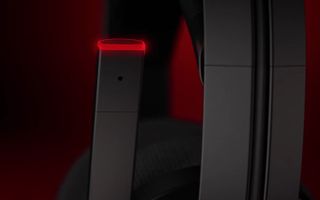HP Omen Mindframe Review: This Headset Cools Your Ears
While the ear-cooling FrostCap technology is interesting, the HP Omen Mindframe is a tough sell all around.
Why you can trust Tom's Guide

I have to give the HP Omen Mindframe ($199 MSRP, $149 from HP) credit right off the bat for trying something new. The headset utilizes a technology known as FrostCap, which aims to keep gamers' ears cool by chilling metal plates inside the ear cups. The technology works as advertised, which is pretty impressive.
What's not impressive, however, is just about everything else about the headset. With its high price, imprecise fit, needless lighting, limited compatibility and just good-enough sound, the Omen Mindframe is a tough sell all around. Even the FrostCap technology doesn't get off unscathed, because using it often feels more strange than refreshing.
It's intriguing to see a gaming peripheral tackle hot ears head-on, but there are better-designed solutions out there.
Design
The Omen Mindframe is both large and heavy, measuring 8.5 inches by 8.5 inches and weighing just about 1 pound. You can't fold the ear cups back, making them difficult to transport. Each ear cup has an Omen logo surrounded by an LED strip. This strip is not full RGB; it can display 18 distinct colors, as well as a few hues in between. They're not necessary, and they're also rather plain compared to what you get on some of the LEDs we've seen on Razer and SteelSeries headsets.
There aren't many extra controls to worry about. There's a volume-control dial on the right ear cup and a boom mic that moves up and down on the left side. You can't remove the mic or retract it entirely. This isn't too much of a problem, though, because the Omen Mindframe connects only via USB. Compare and contrast that with other PC-centric headsets, like the SteelSeries Arctis 5, which give users both USB and 3.5mm options.
FrostCap
While the Omen Mindframe deserves some props for its automatically adjusting headband, its other forward-thinking feature is not nearly as straightforward. The FrostCap technology works as follows: Within each cup, there's a perforated metal plate just in front of the speaker. By using the HP Omen software, you can set the cooling profile at high, medium, low or off. This cools down the metal plates, working like miniature air conditioners.

I was surprised not only that FrostCap works exactly as advertised, but also that the plates cool down so quickly. I sit near a window with western exposure, and no matter how much sun the black headset soaked up, the ear plates stayed nice and cool.
That doesn't necessarily mean the sensation is pleasant, though. When I first learned about the FrostCap technology, I assumed it would radiate coolness throughout the earcups, cooling down the outside of my ears.
Instead, though, it just radiates a cold feeling directly outward — kind of like holding an ice cube an inch away from your ear. It's not all that comfortable; in fact, it gave me a bit of a headache after a few minutes, and I was much happier with the feature disabled entirely. And whether or not I had FrostCap active, the headset itself ran pretty hot, particularly near the LED lights.
MORE: The Best Headsets for Immersive Gaming
Keeping users' ears cool is well and good, but other headsets have handled it better — like the $99 Razer Kraken and its cooling gel within the ear cups or the $299 Victrix Pro AF and its circulating air. Unless your ears usually feel like the inside of Vulcan's forge, you can probably do without FrostCap.
Comfort
The Omen Mindframe's adjustable headband mimics better models from SteelSeries, but because the Mindframe uses plastic rather than elastic, the fit is going to be only almost right, rather than exactly right. Furthermore, because the headset is so heavy, it will weigh down after a while. These two factors combined make for a rather tight fit, although the plush ear cups mitigate that constriction to some extent. I was able to wear the headset for a few hours without much discomfort, but I was always much happier after I took the Mindframe off.

One of my co-workers also tested the Omen Mindframe and said that while she had mixed feelings about the FrostCap, she found the headset comfortable overall. Your opinion will probably depend on how lightweight you like your headsets to be.
Gaming Performance
The Omen Mindframe sounds pretty good with games overall, but you don't have that many options to modify it. The headset employs surround sound, which is fantastic for highly directional games like Overwatch and a little less useful for a game like StarCraft: Remastered, which usually works best with stereo soundscapes.

Otherwise, the treble is a little heavy and voice work can sound a little muddled. This makes narrative-heavy games like Pathfinder: Kingmaker sound a little flat (although that game's soundtrack sounds spectacular). But the setup works well for World of Warcraft, where ambient, environmental sounds are king. The Omen Mindframe provides a consistent sound profile, which should work well for most games but probably won't excel with any genre.
Features
FrostCap is the defining feature of the Omen Mindframe, but the headset can do a few other things. The boom mic is flexible and easy to flip up and down, but it doesn't produce great sound. My voice always came out quiet and a little indistinct. It'll work for online chat, but you should probably speak up.

There are also the aforementioned LED strips, which you can control through the HP Omen software. They can color-cycle (rather abruptly — the colors don't fade into each other, as higher-end headset LEDs do), remain on a static color or turn off completely.
MORE: Best Headphones and Earbuds for Enjoying Music
Surprisingly, the software for this $199 headset doesn't do anything else. There is no set of equalization profiles, no option to toggle between stereo and surround sound, no way to balance chat mix, and no way to tweak mic preferences. I get that the Omen Mindframe requires USB power primarily for FrostCap, but throwing in a few audio options as long as we're tethered to a computer would not have been unreasonable.
Music Performance
The Omen Mindframe is suitable for music, although as with gaming, it doesn't stand out in any particular category. I enjoyed the emphasis on treble in the punk stylings of Flogging Molly, but the gentle bass didn't help Old Crow Medicine Show's bluegrass tunes. Muddied vocals in G.F. Handel's "Messiah" and "Let It Bleed" by the Rolling Stones detracted from the gorgeous instruments in higher frequencies.

Of course, this also assumes that you listen to most of your music while sitting at your gaming computer. Because you can't connect the Omen Mindframe to a 3.5mm audio jack, you can't really use the headset with a mobile phone, tablet or game console.
Bottom Line
The Omen Mindframe's $199 MSRP is way too high for a mediocre headset, but if you can find this item for $150, the value proposition is a little better. FrostCap is a novel technology that could theoretically help out folks whose ears get hot during long gaming sessions.
But FrostCap doesn't work that well, and the rest of the headset is unambitious and overpriced. When you can get an excellent, more versatile headset like the Arctis 5, Kraken TE or Turtle Beach Elite Atlas for $50 less than the Omen Mindframe, there aren't many compelling reasons to go with HP's model other than the cooling technology.
The Omen Mindframe is worth keeping if you got it as a pack-in with a new HP computer. Otherwise, you can get much better headsets for two-thirds of the price — and some of them will even keep your ears cool, too.
Credit: HP
Sign up to get the BEST of Tom’s Guide direct to your inbox.
Upgrade your life with a daily dose of the biggest tech news, lifestyle hacks and our curated analysis. Be the first to know about cutting-edge gadgets and the hottest deals.
Marshall Honorof is a senior editor for Tom's Guide, overseeing the site's coverage of gaming hardware and software. He comes from a science writing background, having studied paleomammalogy, biological anthropology, and the history of science and technology. After hours, you can find him practicing taekwondo or doing deep dives on classic sci-fi.

